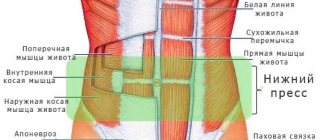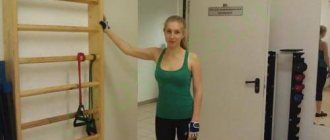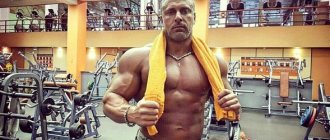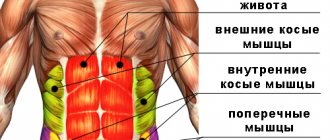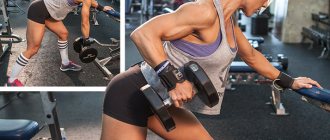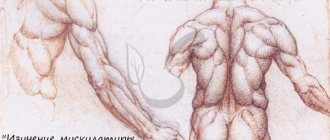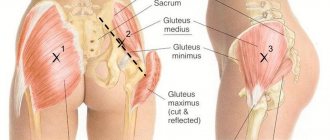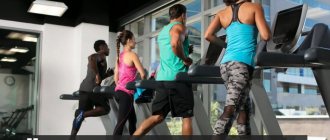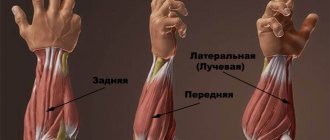Triceps brachii (triceps)
located on the back surface of the shoulder from the shoulder blade to the elbow and is responsible for moving the arm back and bringing the shoulder to the body, and also participates in the extension of the forearm. The triceps (extensor muscle) consists of three heads - long, lateral and medial. The long head begins with a wide tendon from the subarticular tubercle of the scapula. The lateral and medial heads originate on the posterior surface of the humerus. All three heads unite into a flat, wide tendon, which is attached to the olecranon process of the ulna. Triceps injuries are more common in men than in women. Most common for people involved in sports.
Shoulder strain: symptoms of injury
A shoulder injury with sprained muscles and ligaments is always accompanied by severe acute pain. Mobility is immediately lost. The patient cannot bend or straighten the arm at the shoulder and elbow joint. You need to urgently contact a traumatologist. Using an x-ray, fractures and cracks in bone tissue are excluded.
Clinical symptoms of shoulder muscle strain:
- pain in the area of the damaged muscle;
- its palpation is sharply painful, excessive muscle fiber tension and spasm are felt;
- dense extracapsular edema of the inflammatory type forms around the shoulder;
- after a few hours, bruises, bruises, and hematomas may form in the area of the injured muscle;
- mobility in the shoulder joint is either limited or absent;
- general health does not suffer, body temperature remains normal.
We will consider more precise clinical symptoms later in the article - signs of injury to various shoulder muscles are described.
Classic isolation: standing dumbbell swings
Mahami is best to finish
training the middle delta of the shoulder, this will help slightly stretch the middle fascicles. In principle, this exercise is very similar to - it stretches muscle fibers and trains the muscle group as a whole.
How to pump up the middle delta with swings:
- Stand up straight, straighten your back. You can take a dumbbell in each hand or do it alternately, which is most effective
, as it promotes greater concentration on the action. - Swing the dumbbells to shoulder level. You should not hold your hand at the top point.
- Return your hand to the starting position. The return should be carried out gradually
, without jerking, and take 2 times longer than the rise.
Important!
To perform these exercises correctly on the middle deltoids, you should select the appropriate weight.
When the load is too heavy
the athlete stops paying attention to technique: jerks appear, the dumbbell may not reach shoulder level, the body gradually leans forward.
With such errors the exercise loses its isolating quality, and the load spreads to other muscle groups.
Deltoid strain
In the practice of a traumatologist, sprain of the deltoid muscle of the shoulder often occurs not only in athletes, but also in people who have received a domestic injury. A distinctive symptom is the appearance of acute pain when making certain movements with the hand:
- rise to shoulder level;
- bringing in a raised state to oneself;
- touching the supraclavicular area with your fingers.
When the hand is stationary and fixed, there is no pain at all. When you try to make movements involving the acromioclavicular joint, the unpleasant sensations become unbearable.
The primary process of muscle tissue regeneration occurs within 7–9 days. Immediately after this time, rehabilitation must begin. Otherwise, there is a high probability of scar formation and loss of partial function of this muscle.
Anatomy and function of the middle delta
According to anatomical reference books, the deltoid muscle performs the main function of the spinal region - it is responsible for the work of the shoulder blades. And the load on the deltoid muscles is directly affected by the position of the shoulder joint.
- When the arms are lowered and the shoulder blades move, the rear delta works;
- when raised - front;
- the middle bundle plays a connecting role, called .
This department works most efficiently
with the rear delta, because it is closest to it. But for complete isolation, when performing exercises on the middle deltoids, you should reduce the angle in relation to the rear beam.
Biceps brachii strain
When the biceps brachii muscle is sprained, there is another associated injury - displacement of the long head tendon from the groove between the tubercles. If you do not turn to an osteopath and do not set the tendon into this groove, then degenerative thinning of its fibers will soon occur, which will lead to a complete or partial rupture. Therefore, treating a sprained biceps muscle without consulting a doctor is always dangerous because the upper limb may completely lose its functionality in the near future.
Clinical signs of this injury:
- pain in the shoulder joint and excessive tension in the arm muscles;
- painful palpation in the area where the long head of the muscle passes;
- muscle tone is reduced;
- supination of the arm bent at the elbow joint is impossible;
- When trying to make movements in the shoulder joint, crepitus and a click characteristic of tenosynovitis occur.
Treatment is carried out after repositioning the tendon. Limb fixation and limitation of physical activity are prescribed for 5-7 days. Then a course of restorative rehabilitation is prescribed using physiotherapy, manual therapy, acupuncture, physical therapy, etc.
Diagnosis of pain in the delta region
For an accurate diagnosis of when the anterior or posterior deltoid hurts, you need to determine the location of the pain, find out how the syndrome began to develop and verify the presence/absence of specific signs that accompany muscle pain.
Diagnosis begins with examining the patient and determining the symmetry of the shoulder blades, collarbones and upper limbs. Using palpation, the muscles are examined for the presence of hypotrophied areas.
The deltoids are checked for possible cuts and tested to determine balance and the ratio of passive and active movements. You also need to check the strength of the flexor and extensor muscles. Doctors identify important diagnostic trigger points to confirm fibromyalgia. Finally, specialists palpate the radicular exit points to identify signs of radicular damage.
To confirm the diagnosis, X-rays, ultrasound, MRI and CT may be required, as well as electrophysiological studies to determine the tone of muscle tissue.
Supraspinatus Strain
The supraspinatus muscle is part of the so-called “rotator cuff”, which provides the ability to rotate and rotate the shoulder joint to the outside. Stretching the supraspinatus muscle of the shoulder leads to the fact that such movements become difficult and sometimes completely impossible.
The clinical symptom is pain that occurs after unsuccessful rotation of the shoulder. Unpleasant sensations are localized in the area of the front of the arm. Pain intensifies at night. During the day, the injury may not show obvious signs. But this does not mean that it can be left without treatment.
The fact is that a sprain of the supraspinatus muscle is always associated with a concomitant strain of the biceps tendon. If this is not treated, then over time the patient's range of motion is limited. In particular, he will not be able to fully move his arm to the side and lift it up. This will make it difficult to comb your hair, fasten your bra, or remove anything from your back pants pocket.
Shoulder Exercises, Sets and Reps
Rear delts
To pump up the posterior deltoid muscle, 3-4 working approaches (excluding warm-up) in an isolation exercise should be enough.
It may seem like one exercise isn't enough, but remember that one of the functions of the rear deltoids is to externally rotate the humerus. So if you're doing a few shoulder external rotation exercises each week (as you should be) during your back workouts, then a few sets of one exercise will likely be sufficient.
However, if your rear delts are seriously underdeveloped, then perform two exercises that isolate the rear delts. Perform three sets of each exercise. Here are three effective exercises to choose from:
- Rear deltoids in a standing block
- Bent-over dumbbell swings or rows on the rear delts with your head resting on an incline bench
- Bent-over dumbbell row with rotation Video with exercise technique
Please note that this is not a triceps exercise. This is a movement where you keep your elbows straight and pull your arms back using only your rear delts.
Beware of lifting the scapula to isolate the rear deltoid, keeping the shoulders down at all times. Keep in mind that the function of the posterior deltoid is simply to move the humerus backward without squeezing the shoulder blades together.
No matter what type of rear delt exercise you perform, there are several biomechanical principles to consider. For beginners, to optimize the work of the rear delts, train them at the optimal line of pull, which is formed when the shoulders are abducted (to the sides) by 35-40˚.
It is also necessary to raise your arms with dumbbells in line with your shoulders, pointing your little fingers up. This will align the rear deltoid so that it does the maximum work possible.
When isolating the rear deltoid, the challenge for most people is actually isolating the deltoid to effectively contract the muscle. For this reason, exercises are often performed with light weights with repetitions of 10-15. Performing the exercise with heavy weights for low repetitions is more effective, but wait until the neuromuscular connection of the rear deltoids improves before moving on to heavier weights.
Front delts
Standing chest press
To train the anterior deltoid muscle, a barbell chest press is usually used. This is a good exercise to train your shoulders. This is a basic shoulder exercise.
The front delt press can be done with a barbell or dumbbells. It is imperative to change exercises to include shoulder muscle stabilizers to keep your shoulders healthy
Also, bench presses are for the front delts as squats are for the quads. On the other hand, forward raises isolate the front delts in the same way that leg extensions isolate the quadriceps.
If the front delts are your strong point, then focus on the overhead press, with occasional front raises to complement it. This combined with the bench press is all you need to train your delts.
On the other hand, if you need to increase your front delts, then it is better to perform one dumbbell or barbell front raise in addition to the overhead press.
The two best exercises for pressing are the basic barbell overhead press (seated or standing) and the basic dumbbell press, performed seated or standing. Although many set/rep schemes for the overhead press work, it is better to stick with 4*6-10, although 5*5 and 3*8-12 are also good options that should be done correctly.
When it comes to isolating the front delts from the rear, dumbbell front raises are great, but barbell front raises are more effective.
No matter which front raise you choose, make sure the bar is at a 110˚ angle, approximately level with the top of your forehead. This is the peak at which the front delts contract, rather than at 90˚ where most people stop.
When performing variations of front raises, it is preferable to choose a rep range of 3*10-12, sometimes take more weight and do 6-8 reps, sometimes less and do 12-15,
Middle deltas
If you want to have shoulders like bodybuilders, you should always include variations of lateral raises to accentuate the middle delts, the most fundamental of which is dumbbell lateral swings.
Even though most people perform lateral dumbbell swings, many do it incorrectly.
For optimal tension of the middle deltoid muscles, the palms should be facing down at the top point. Or, if you really want to hit them hard, tilt the end of the dumbbells down a few degrees so that the inside of your arm rotates slightly upward.
Also, the wrists, elbows and shoulders should be at the same level at the top. Also, the point of your elbow should be pointing straight back, not toward the floor.
At the top of the movement, most people tend to angle the side of the dumbbells too high, causing their wrists to be higher than their elbows. This is because the pattern of this movement allows the front delt to become more dominant to help you out more than you want.
People with very strong upper trapezius muscles also tend to press the dumbbells at a finish position angle close to 90˚. To avoid this, think about pushing the dumbbells out to the sides.
For variety, you can change the point of maximum tension of the middle deltoid muscle by performing one of the following exercise options:
- Lie on your side on an incline bench. Perform dumbbell swings, raising your arm to a 90˚ angle, where the peak contraction of the middle deltoids occurs.
- Bend your torso to the side with the weight as in the video:
If you need to increase your middle delts, it's common to perform three sets of two different shoulder abduction exercises (lateral raises). Perform one exercise in three sets of 8-12 repetitions, and the other in three sets of 12-15. And as usual, sometimes do more difficult or easier ones.
Two Continuous Shoulder Workouts
There are two fundamental, serious shoulder training programs, each targeting different shoulder deficiencies.
- For lagging middle and rear delts (but well developed front delts):
- For lagging front delts (but good middle delts):
First of all, you need to make a correct diagnosis.
First:
You actually pulled the anterior deltoid muscle.
Second:
You have tendinitis in your shoulder and biceps. Although this is usually mistaken for a shoulder injury (after all, it is the shoulder that hurts), biceps tendonitis is actually the result of the superior biceps tendon coming out of its bed at the upper end of the humerus - the humerus. The pain is felt under the anterior deltoid muscle and is therefore often mistaken for a shoulder injury. This is usually misdiagnosed as bursitis or a sprained shoulder girdle. If the biceps tendon is not put back into place, it will cause shoulder disease because the biceps ligament stabilizes the shoulder joints. When it is not in the right place, the lateral and posterior shoulder joints experience additional stress and gradually become inflamed and painful. Ultimately, everything may end in separation of the shoulder joint.
After reading your answer to my question, I decided to go to the Luzhniki physical education and medical dispensary. The surgeon, having examined me, reassured me, saying that it was periarthritis of the delta, and prescribed me Butadion ointment twice a day and Ortofen tablets twice a day, as well as physiotherapy. If this does not help, then “Blockade”, as far as I understand, is the injection of medicine directly into the source of pain. For about 5 days I have been taking Ortofen and using Butadione, the pain has become less, but I have not trained for 10 days. I want to start training because my muscles are starting to lose tone. Maybe tell me how to train correctly in my situation, and where I can get advice on organizing the training process and technique for performing exercises, since I live in the Moscow region.
Sincerely, Alexander.
I must say that your attitude towards our sport deserves respect. Continuing in the same spirit, you will certainly achieve significant success, and perhaps in 5-10 years I will still be proud to know you. Let's hope that the diagnosis is made accurately and the injury will not just be healed, but completely cured.
Subscapularis sprain
When the subscapularis muscle of the shoulder is stretched, characteristic pain appears, a decrease in the amplitude of internal rotation of the arm and an increase in external rotation. A number of specific functional tests are used for diagnosis.
The patient is asked to press the palm of the hand on the affected side to the lower back while moving the elbow back as far as possible. In this position, you are asked to tear your hand off your lower back and raise it to the maximum possible distance. The smaller it is, the larger the area of muscle injury.
A similar test can be done by asking the victim to press his or her palm against the anterior abdominal wall. Then he should move his elbow forward as much as possible. If this movement is difficult or impossible, the test is considered positive.
Next test: you need to place the hand on the side of the injury on the opposite shoulder in front of you. The doctor should try to remove the hand from the shoulder, and the patient should try to keep it there. If he fails, the test is considered positive.
Video
The deltoid muscle, originating from the collarbone and scapula, extends along the shoulder to the upper part of the forearm. It is also known as triceps, as it consists of three bundles, and its shape resembles the Greek letter “delta”. Thanks to the deltoid muscle covering the shoulder, the latter has a characteristic round shape.
The deltoid muscle consists of anterior, middle and posterior parts, each of which functions in its own way. At the same time, all three parts are simultaneously responsible for raising the arm and reliably holding the humerus within specified limits during the movement.
Shoulder muscle strain: what to do, how to treat?
Please note: before treating a shoulder muscle strain, you must visit a traumatologist. Very often, such injuries mask more serious damage to bone and ligamentous tissue. Only an experienced specialist will be able to exclude a fracture, crack, dislocation, rupture of soft tissue, etc. using special examinations.
The first thing to do when you have a shoulder muscle strain is to avoid any physical activity for 5-7 days. It is necessary for damaged muscle fibers to regenerate and restore their functionality. Therefore, a fixing bandage is first applied. To reduce pain levels, non-steroidal anti-inflammatory ointments can be applied externally.
There are several ways to get rid of a muscle strain on the shoulder, all of them involve manual manipulation. Unfortunately, there are currently no pharmacological drugs that can restore muscle tissue. All that a traumatologist or surgeon prescribes are drugs to eliminate symptoms. They do not have a healing effect on the muscles themselves. We’ll talk about how to properly treat the consequences of this injury later in the article.
Stretching the front of the shoulder
There are several ways to stretch the muscles at the front of the shoulder.
Variations:
Place your palms on your lower back. Try to bring your elbows together behind your back.
Muscles involved:
deltoid pectoralis major
Stretching is a comprehensive training technique that stretches the limbs of the body and muscles. It received its original name “stretching” due to the fact that it began to be practiced separately from aerobic exercises, in order to improve the health of the body and give it flexibility.
Stretching the front of the shoulder. Option No2
For this shoulder girdle training exercise, you can use furniture, a doorway and other stable objects, as shown in the picture
Muscles involved:
deltoid pectoralis major
Chest stretching
Muscles involved:
Pectoralis major muscle
Pectoral muscles
Stretching the pectoral muscles and shoulder girdle with the help of a partner
Exercises done with the help of a partner can be quite effective. The main thing is to control the process and tell your partner when you need to stop the stretching exercise.
- Stand straight and clasp your hands behind your back, raising them slightly.
- Your partner should stand behind you and hold your hands.
- Ask your partner to apply gentle pressure on your hands around the wrists.
- Hold this position for 10-30 seconds.
Muscles involved:
Pectoralis major muscle
Pectoralis minor muscle
Treatment of shoulder sprains and muscles
Effective treatment of shoulder sprains and ligaments is possible only with the help of manual therapy methods. First you need to wait until primary recovery has completely occurred. After this, you need to contact an osteopath or chiropractor. Doctors will develop an individual treatment plan for a shoulder strain.
Our manual therapy clinic uses the following techniques for these purposes:
- osteopathy and massage;
- kinesiotherapy and therapeutic exercises;
- physiotherapy and laser treatment;
- acupuncture, etc.
The course of treatment is always developed individually for each patient. It is important to restore impaired blood microcirculation and prevent the formation of rough scar tissue. Then the doctor directs his efforts to restore the tone of the damaged muscle.
Types of muscle pain
Muscle pain is not an indicator of muscle growth or strength. Pain is a sign that you have worked hard, that the muscles have received a significant load on them
Due to the fact that in the programs of bodybuilders or other athletes (fitness, workout, weightlifting) the training has varying degrees of severity (light, medium and heavy), the muscles receive different loads and, as a result, different degrees of “injury”. Due to such prerequisites, muscle pain can appear at different times: a day later, two days later, or immediately after finishing the exercise.
It’s interesting, but bodybuilders perceive the complete absence of such pain in the muscles negatively. This is due to the fact that the body is already accustomed to the load, and a workout that did not cause pain was wasted. “No pain, no growth.”
Normal moderate muscle pain after exercise. As a rule, this type of pain appears after sleep or almost exactly one day after training. This type is considered the most optimal and favorable for muscle growth, physical qualities and constant progress. Based on these sensations, one can approximately say with what intensity, weights of weights and how many approaches the athlete worked. This is a medium intensity level, weights vary from 70 to 80% of the maximum, and sets range from 4 to 6.
Delayed muscle pain. Typically, the period of its occurrence is an average of 48 hours after training. Naturally, such a delay in the protective and developmental mechanisms of the body leads to a greater expenditure of time to achieve certain goals. That is, you will have to rest longer, which means training will be less frequent. If delayed pain occurs, you can judge the nature of the training - it was hard. The body was simply not ready for such stress, and it took time for it to launch all the necessary processes.
Muscle pain from injury. This type differs from the previous two in that it is not predictable: it can occur right during the exercise, immediately after it, or simultaneously with the usual moderate pain the next day. It has a more long-lasting nature: if the two previous types of pain disappear in 2 or 3 days, then the pain from the injury will disappear along with the injury itself. And damage heals slowly, especially serious ones. One such injury is a sprain. The nature of the pain from an injury is more acute than pain from stress: if you touch it, the usual or delayed pain is more dull, while from an injury it is more acute. It's hard to confuse them.
How to prevent post-workout pain
There are several simple ways to reduce or almost completely eliminate muscle pain after intense exercise:
– warm-up and stretching;
– massage or self-massage;
- cold and hot shower;
– consumption of large amounts of carbohydrates (sports nutrition);
– hot bath or sauna.
Let's go through each point.
During the process of growth and aging, changes occur in muscle tissue. Incorporating warm-up and stretching into a regular training schedule will ensure uniform muscle growth along the fibers and increase the level of flexibility. This will give you the ability to move in any direction with ease and provide more energy to perform various actions.
Massage in any form stimulates the outflow of blood and lymph from tight muscles, which reduces their size and micro-tears. As a result, the pain the next day will be much less.
A contrast shower for 3 to 5 minutes immediately after training allows you to narrow and dilate blood vessels, which has a beneficial effect on the outflow of blood from “clogged” muscles. Naturally, the pain should be less.
Carbohydrate foods or sports nutrition with a carbohydrate base (preferable, of course), for example, any type of gainer (high-carbohydrate or high-protein), allow you to quickly restore glycogen in the muscles, saturate the cells with energy , which will affect muscle recovery during sleep. The recovery rate in this case is the highest, and the pain the next day, as a rule, disappears completely.
Like a contrast shower, a hot bath or sauna promotes certain processes in the body that have a beneficial effect on the subsequent rest of “damaged” muscle tissue . In addition, a very warm environment relaxes and improves the quality of sleep, which cannot but affect your vacation as a whole.
Causes of biceps strain
One of the causes of muscle injury is tissue overstrain due to sudden movement. So, for example, a strain in the biceps of the arm can occur during improper stretching of the muscle or as a result of its sharp contraction due to the effort that has to be applied to perform an exercise or other physical activity.
A distinction is made between complete and partial muscle rupture, also called an arm muscle strain. The degree of injury is determined by the strength of muscle contractions and the size of the load. The entire muscle or just a few of its fibers may rupture. The most common injury is mild sprains; they can occur both in people who are intensely involved in sports and in people who neglect physical education.
